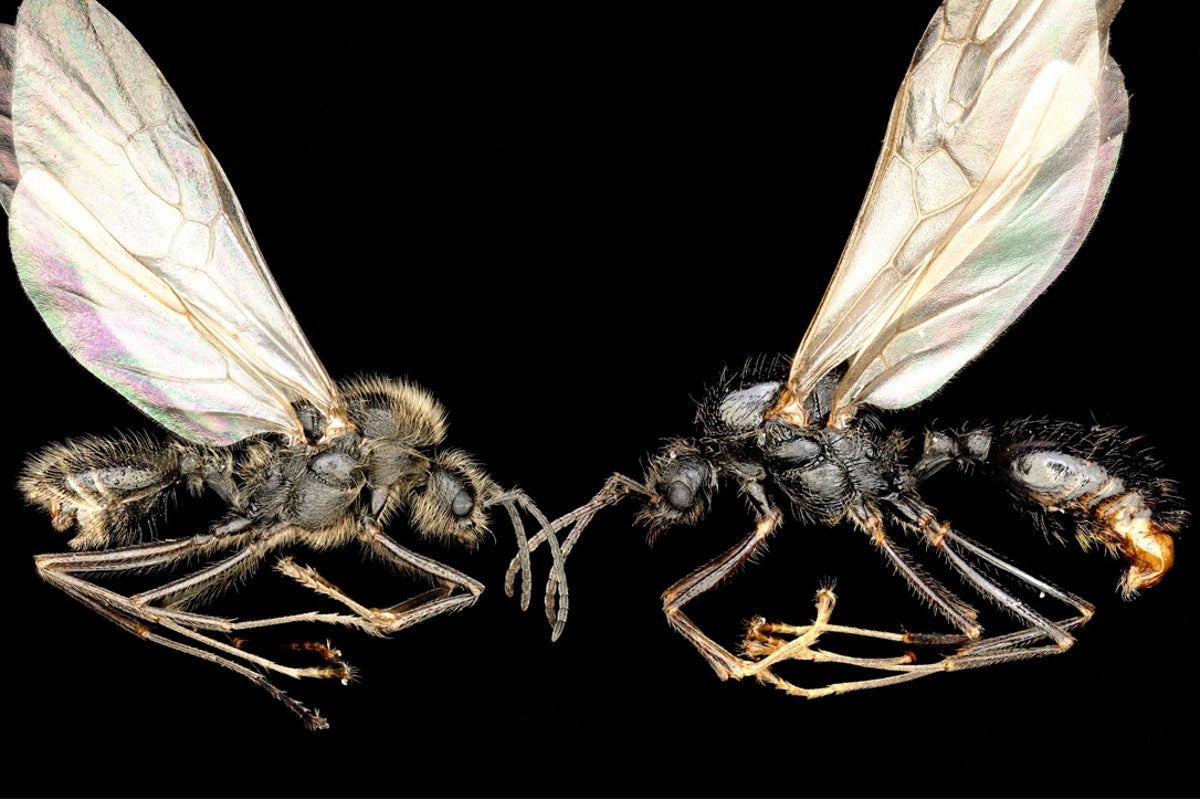These Ants Are Different Species but Share a Mother
Ant queens of one species are sexual parasites that clone ants of another species to create hybrid workers that do their bidding
Queen Iberian harvester ants (Messor ibericus) can give birth to ants of their own species (left) and, using a cloning trick, offspring of a different one (Messor structor, right).
Join Our Community of Science Lovers!
Data now show that, in the absence of nearby M. structor colonies, M. ibericus queens can clone male M. structor ants by laying eggs that contain only M. structor DNA in their nuclei. The findings were published in Nature on 3 September.
If you’re enjoying this article, consider supporting our award-winning journalism by subscribing. By purchasing a subscription you are helping to ensure the future of impactful stories about the discoveries and ideas shaping our world today.
Iberian harvester ants co-exist with M. structor in some parts of Europe, which has historically given M. ibericus queens an abundant supply of M. structor males to mate with.
When the researchers peered inside colonies of the Iberian harvester ant, they found two types of ant that looked very different. Genetic analyses confirmed that the colonies contained both M. ibericus and M. structor, despite the lack of M. structor populations on the island.
Further analyses solved the mystery: Iberian harvester queens clone M. structor ants to maintain a supply of their sperm. They then mate with those M. structor ants to produce hybrid workers that take care of the colony, including by building the nest and foraging for food. In effect, M. ibericus has domesticated M. structor and its genome, Romiguier says.
The two species diverged more than five million years ago, so it’s wild to see one species producing the other, Romiguier adds. “That’s almost how long ago humans and chimpanzees diverged.”
Intriguingly, when the researchers put the M. structor ants cloned by the Iberian harvester ants into a regular M. structor colony, the insects were killed for being foreign invaders, despite looking nearly identical to those in the colony. That’s because the cloned ants carried the pheromones of their Iberian cousins, so they were treated as enemies, Romiguier says. Another way that they are different from the ants in the M. structor colony is that, although the clones have only M. structor DNA in the nuclei of their cells, they carry M. ibericus DNA in their mitochondria — the cells’ energy-producing units.
Romiguier says that this domestication of the M. structor genome resembles the beneficial partnership that led to mitochondria becoming part of the eukaryotic cell more than one billion years ago after a primitive host cell engulfed a bacterium. Today, eukaryotes — which include all animals, plants and fungi — also have two distinct genomes in their cells: one in the nucleus and one in the mitochondria. But Boomsma does not expect M. ibericus’s rare sexual parasitism to be nearly as evolutionarily successful as eukaryotes’ acquisition of mitochondria and spread to other organisms.
This article is reproduced with permission and was first published on September 3, 2025.
Max Kozlov is a science journalist at Nature whose work has appeared in the Atlantic, Nature, Quanta Magazine and Science, among other publications.
First published in 1869, Nature is the world’s leading multidisciplinary science journal. Nature publishes the finest peer-reviewed research that drives ground-breaking discovery, and is read by thought-leaders and decision-makers around the world.
If you enjoyed this article, I’d like to ask for your support. Scientific American has served as an advocate for science and industry for 180 years, and right now may be the most critical moment in that two-century history.
I’ve been a Scientific American subscriber since I was 12 years old, and it helped shape the way I look at the world. SciAm always educates and delights me, and inspires a sense of awe for our vast, beautiful universe. I hope it does that for you, too.
If you , you help ensure that our coverage is centered on meaningful research and discovery; that we have the resources to report on the decisions that threaten labs across the U.S.; and that we support both budding and working scientists at a time when the value of science itself too often goes unrecognized.
In return, you get essential news, captivating podcasts, brilliant infographics, , must-watch videos, challenging games, and the science world’s best writing and reporting. You can even gift someone a subscription.
There has never been a more important time for us to stand up and show why science matters. I hope you’ll support us in that mission.
Thank you,
David M. Ewalt, Editor in Chief, Scientific American
Source: www.scientificamerican.com
